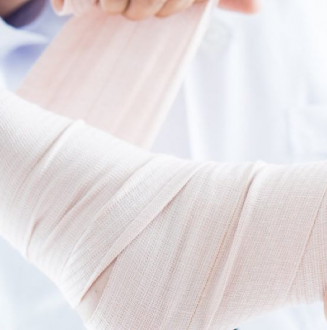A Marjolin ulcer is an unusual and severe form of skin carcinoma that develops from burns, poorly-healed wounds, or scars. It develops gradually but eventually spreads to other organs, including the lungs, brain, kidneys, and liver. Marjolin ulcers appear as flat, hard lesions in the area of a wound or burn that do not heal for three months or more in the early stages. They frequently manifest themselves first as a tender blister developing on top of an existing scar.
As the wound develops, it is not uncommon for the patient to endure significant pain, bleeding, crusting, and foul-smelling pus as the wound progresses.
Various other cell types also develop these ulcers, but the most common form of malignancy that is found frequently is basal cell carcinoma. Lesions are invasive, with a poor prognosis and a high recurrence incidence. Prevention is the most important thing. This is done by taking care of burn wounds properly and noticing early signs of malignant change, which are treated with surgery if possible.
Marjolin Ulcer Symptoms
Most of the time, a Marjolin ulcer looks like a wound or scar that is not healing, possesses an ulcer, or is hardened. It grows consistently in size, possesses abundant granulation tissue, rolling raised borders, putrid-smelling pus, bleeds freely, and is uncomfortable. Marjolin ulcers, when examined, are typically flat and indurated (meaning they become hard), and they hold raised margins.
Exophytic granulation tissue, hemorrhage, and regional lymphadenopathy are other clinical symptoms that suggest the establishment of a Marjolin ulcer. The exophytic form is less prevalent and less aggressive than the ulcerative variant. The first symptom that mostly appears is a superinfection of the wound.
Lesions appear everywhere on the body, but the lower limbs, scalp, upper extremities, chest, and face are the most commonly affected. During routine physical examinations, medical professionals are recommended to pay particular attention to all old scars and carefully note any changes that occur during previous visits.
Marjolin Ulcer Causes
The specific cause of Marjolin ulcers is uncertain. According to several views, damage and scarring destroy local lymphatic and blood channels, making the area immune-privileged. In this way, the scar is shielded from anti-tumor antibodies, allowing the skin to change and become cancerous. Chronic inflammation, irritation, and damage to the area are likely to play a role in the progression.
Some chronic inflammatory etiologies that lead to Marjolin ulcers are:
- Hidradenitis Suppurativa.
- Bites and Stings.
- Radiation dermatitis.
- Pressure ulcers.
- Osteomyelitis.
- Venous stasis ulcers.
- Traumatic wounds.
Incisional biopsy of suspected ulcer regions is used to diagnose these ulcers. A histological look at the sample shows changes that refer to cancer. As Marjolin ulcers are often misinterpreted as pseudoepitheliomatous hyperplasia, this necessitates a multidisciplinary approach.
Marjolin Ulcer Types
Marjolin ulcers are most usually caused by burn scars. Squamous cell carcinoma is the most prevalent kind of marjolin ulcer. It is important to take biopsies of any worrisome lesions.
Marjolin’s ulcers are uncommon and most usually happen in the lower extremities, particularly the heels and plantar feet. In the majority of cases, a Marjolin ulcer develops where a thermal burn scar is previously present.
Marjolin Ulcer Treatment
To reduce the risk of malignant degeneration, management is recommended to emphasize preventing subsequently healed burn wounds from becoming infected. There is no definitive treatment regimen for Marjolin ulcers once they are discovered.
Marjolin ulcers are commonly treated with Mohs surgery, which removes the malignancy. There are various stages to the procedure. The doctor removes a portion of the skin, examines it with the help of a microscope, and repeats the procedure when there are no more cancer cells left. Following the procedure, the doctor proposes a skin graft to cover the injured skin. Some other therapies are also prescribed by the doctor such as amputation, chemotherapy, and radiation therapy.
In the treatment of Marjolin ulcers, neither radiotherapy nor chemotherapy is proven successful. In circumstances where surgical treatment is not feasible or denied, radiation is utilized for palliation. Patients who are identified with the Marjolin ulcer are required to participate in long-term follow-up for a minimum of three years.
Marjolin ulcer’s prognosis is heavily influenced by whether or not the malignancy progresses to the lymph nodes. Lesions are aggressive and possess a dismal prognosis, even though the majority of Marjolin ulcers are well-differentiated.
 Health & Care Information
Health & Care Information 


